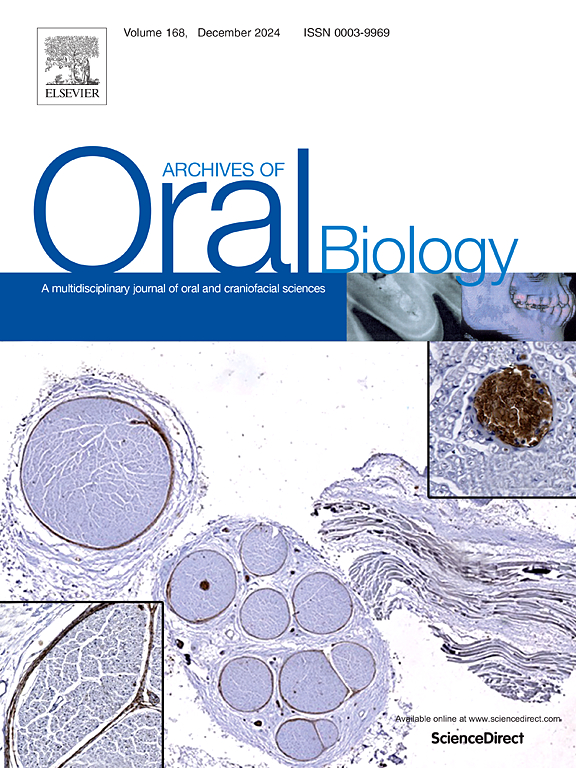Bioinformatics-driven salivary microbial and functional profiling for identifying biomarkers in oral cancer and tobacco abusers in the Indian population
IF 2.1
4区 医学
Q2 DENTISTRY, ORAL SURGERY & MEDICINE
引用次数: 0
Abstract
Objective
To investigate alterations in the salivary microbiome and its functional potential in Oral Squamous Cell Carcinoma (OSCC) patients, tobacco abusers, and healthy individuals in order to identify microbial biomarkers and gain insight into OSCC pathogenesis.
Design
Saliva-derived 16S rRNA gene sequences from OSCC patients, tobacco users, and healthy controls were obtained from the Indian Biological Data Centre (IBDC). Taxonomic classification was performed using QIIME2, and functional prediction was conducted with MicFunPred. Alpha and beta diversity, differential abundance, and pathway enrichment analyses were used to compare microbial communities and functions among the groups.
Results
OSCC samples showed significantly reduced alpha diversity and distinct microbial community profiles relative to healthy controls. Genera including Porphyromonas, Streptococcus, Rothia, and Parvimonas were enriched in OSCC and are associated with inflammation and carcinogenesis. Tobacco users exhibited increased microbial richness, with dominance of Prevotella, Veillonella, and Peptostreptococcus, indicative of adaptation to chemical exposure. Functional predictions in OSCC samples indicated enrichment in pathways related to bacterial chemotaxis, lipopolysaccharide biosynthesis, glycolysis, and DNA repair. Tobacco-associated microbiota showed elevated oxidative stress response and detoxification pathways.
Conclusions
Microbial dysbiosis and functional alterations in the oral microbiome are strongly associated with OSCC and tobacco use. The identification of disease-specific microbial signatures and pathways highlights the potential of the oral microbiome as a non-invasive biomarker and therapeutic target for precision medicine in OSCC, particularly in the Indian population.
生物信息学驱动的唾液微生物和功能分析用于识别印度人口口腔癌和烟草滥用者的生物标志物
目的探讨口腔鳞状细胞癌(OSCC)患者、烟草滥用者和健康人唾液微生物组的变化及其功能潜力,以鉴定口腔鳞状细胞癌的微生物生物标志物,并进一步了解OSCC的发病机制。设计从印度生物数据中心(IBDC)获得OSCC患者、吸烟者和健康对照者唾液来源的16S rRNA基因序列。用QIIME2进行分类,用MicFunPred进行功能预测。α和β多样性、差异丰度和途径富集分析用于比较各组之间的微生物群落和功能。结果与健康对照相比,soscc样品α多样性显著降低,微生物群落特征明显。包括卟啉单胞菌、链球菌、罗氏单胞菌和细小单胞菌在内的属在OSCC中富集,并与炎症和致癌有关。烟草使用者表现出增加的微生物丰富度,以普雷沃氏菌、细孔菌和胃链球菌为主,表明对化学暴露的适应。OSCC样品的功能预测表明,与细菌趋化性、脂多糖生物合成、糖酵解和DNA修复相关的途径富集。烟草相关微生物群表现出氧化应激反应和解毒途径的升高。结论口腔微生物菌群失调和功能改变与OSCC和烟草使用密切相关。疾病特异性微生物特征和途径的鉴定突出了口腔微生物组作为OSCC非侵入性生物标志物和精准医学治疗靶点的潜力,特别是在印度人群中。
本文章由计算机程序翻译,如有差异,请以英文原文为准。
求助全文
约1分钟内获得全文
求助全文
来源期刊

Archives of oral biology
医学-牙科与口腔外科
CiteScore
5.10
自引率
3.30%
发文量
177
审稿时长
26 days
期刊介绍:
Archives of Oral Biology is an international journal which aims to publish papers of the highest scientific quality in the oral and craniofacial sciences. The journal is particularly interested in research which advances knowledge in the mechanisms of craniofacial development and disease, including:
Cell and molecular biology
Molecular genetics
Immunology
Pathogenesis
Cellular microbiology
Embryology
Syndromology
Forensic dentistry
 求助内容:
求助内容: 应助结果提醒方式:
应助结果提醒方式:


